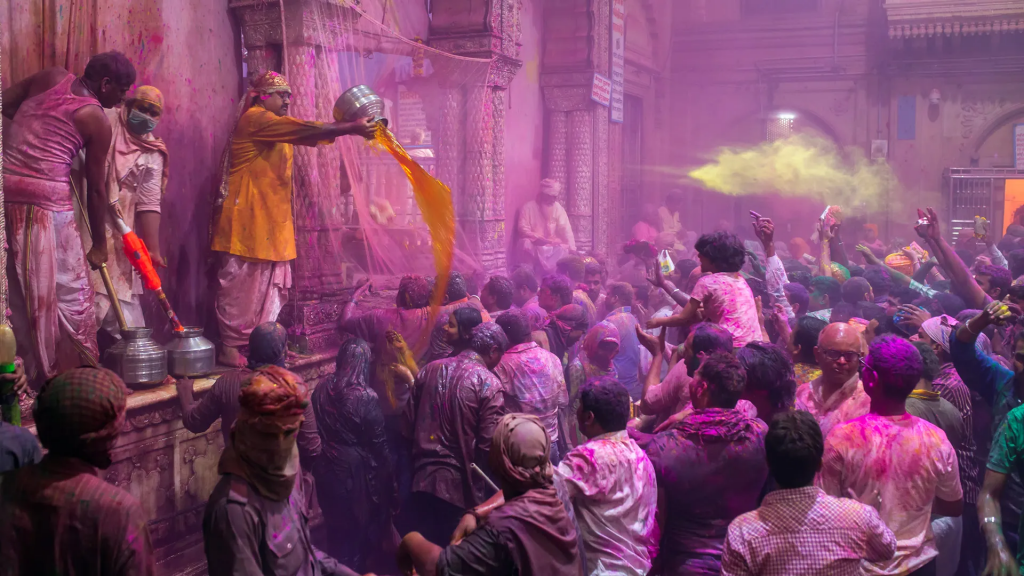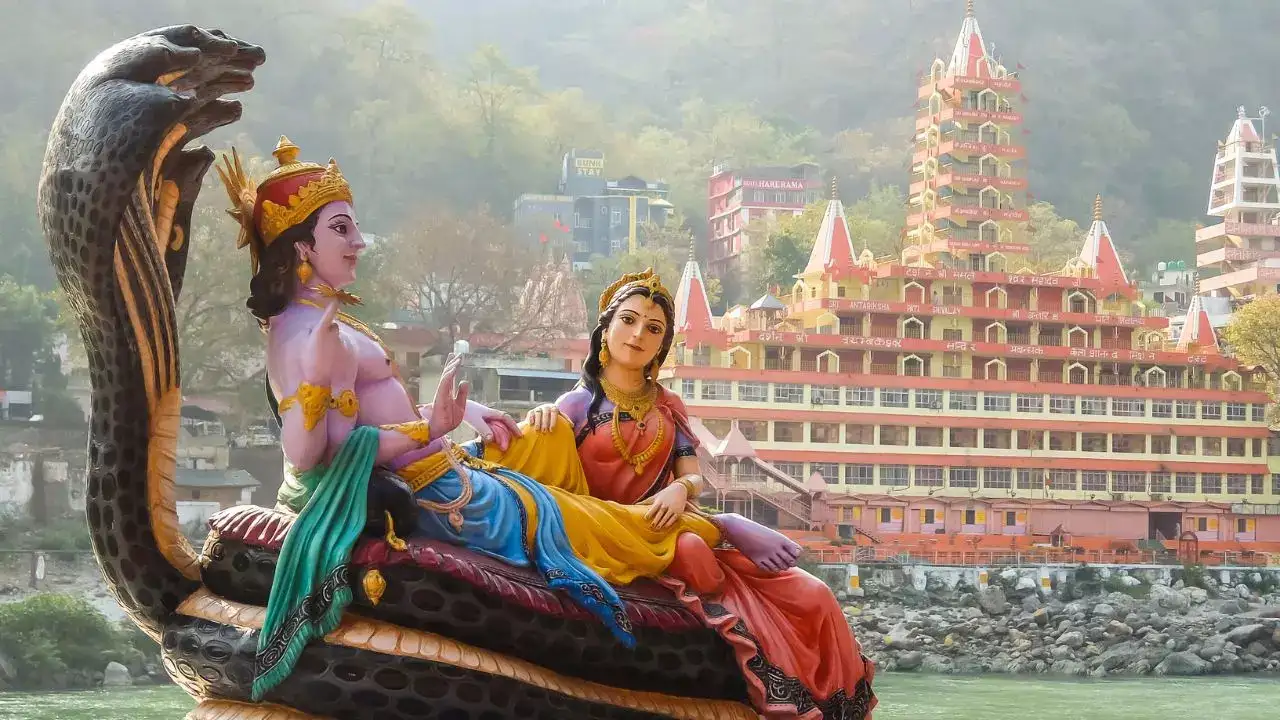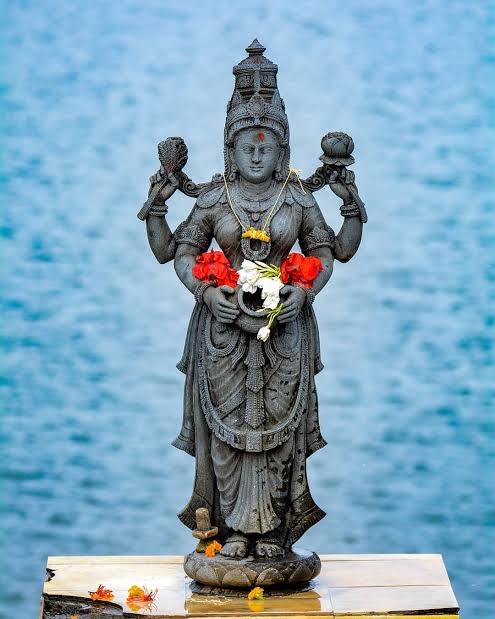Holi, widely celebrated as the Festival of Colours, marks a significant chapter in the cultural and spiritual calendar of Bharat. It heralds the arrival of spring, symbolizing the victory of good over evil and the enduring love of Bhagawan Krishna and Radha.
This vibrant festival, second only to Diwali in its grandeur among Hindu celebrations, paints the canvas of Bharat with a spectrum of colours. It brings together people from different walks of life, transcending social boundaries in a jubilant expression of unity, forgiveness, and renewal.
As the full moon illuminates the sky in the month of Phalguna, communities ignite the Holika bonfire, signifying the burning away of the old and the ushering in of the new. The following day, the air fills with the joyous colors of Rangwali Holi, making it a vivid celebration of life, love, and mirth.

Holi: The Festival of Colours
- Holi
- Foundations of Holi
- Legend of Holika and Prahlada
- Divine Play of Krishna and Radha
- Significance of Kamdev and Lord Shiva in Holi
- Celebrations Across Bharat
- The Vibrant Braj Holi
- Holika Dahan: The Sacred Fire Ritual
- Rangwali Holi (Dhuleti) : A Spectrum of Joy
- Holi Rituals and Customs
- Holika Puja Vidhi: A Devotional Blueprint
- Choosing the Auspicious Muhurta for Holika Dahan
- The Traditional Use of Tesu ke Phool
- Holi Across the Globe: Unity in Diversity
- Traditional Holi Delicacies
- Professional Tips for a Safe and Reverent Holi
Holi
Holi, often referred to as the Festival of Colors, is one of the most exuberant and revered festivals celebrated by Hindus around the globe. Marking the arrival of spring, it is typically observed on the full moon day in the month of Phalguna, which falls around late February or March in the Gregorian calendar.
This vibrant festival transcends beyond just splashing colors; it embodies the triumph of good over evil, inspired by ancient legends, and commemorates the divine love of Radha and Krishna.
Legends worshiped during Holi
Holi is deeply rooted in Hindu Scriptures and Itihasas, with several legends commemorating the festival’s significance. Each story highlights the triumph of good over evil, devotion, and divine love, forming the spiritual essence of this vibrant celebration.
1. Holika and Prahlada
The legend of Holika and Prahlada is one of the most pivotal narratives associated with Holi, stemming from the Bhagavata Purana. Prahlada was a devout follower of Bhagwan Vishnu, much to the dismay of his father, Hiranyakashipu, a demon king who had been granted a boon that made him virtually indestructible.
Determined to eliminate his son’s devotion to Vishnu, Hiranyakashipu subjected Prahlada to numerous attempts on his life. Holika, Prahlada’s aunt, who had a boon that fire could not harm her, tricked him into sitting on a pyre with her. However, through the grace of Lord Vishnu, the boon reversed, protecting Prahlada from the flames while Holika was consumed.
This miraculous event is commemorated on Holika Dahan, symbolizing the victory of faith and goodness over malice and arrogance.
2. Divine Play of Krishna and Radha
The celebrations of Holi in the Braj region of Bharat are inspired by the divine love and playful antics of Bhagawan Krishna and Radha. Krishna, known for his mischievous nature, was envious of Radha’s fair complexion and, upon the playful suggestion of his mother Yashoda, decided to apply color to Radha’s face.
This act of coloring Radha and the gopis became emblematic of Holi, symbolizing the joyous and loving spirit of the festival. The Skanda Purana and other scriptures recount these leelas (divine play) of Krishna in Vrindavan, highlighting the themes of divine love, joy, and the communal celebration of life.
3. Kamadeva and Lord Shiva
Another significant narrative is that of Kamadeva, the god of love, and Bhagawan Shiva, as recounted in various scriptures including the Shiva Purana. After the self-immolation of Sati, Bhagawan Shiva retreated into deep meditation. Parvati, reborn as Sati, sought to attract Shiva’s attention to marry him.

Kamadeva was tasked with disrupting Shiva’s meditation by shooting him with the arrow of desire. Angered by the disturbance, Shiva opened his third eye and reduced Kamadeva to ashes. However, moved by the pleas of Kamadeva’s wife, Rati, and Parvati, Shiva later resurrected him.
This story is associated with Holi, symbolizing the sacrifice of Kamadeva, the power of devotion, and the cycle of destruction and regeneration.
These revered narratives from Hindu Scriptures and Itihasas not only provide the mythological backdrop for the Holi festival but also impart moral and spiritual lessons that transcend the celebration itself. Holi, thus, becomes a time for reflection on these eternal values, fostering a deeper connection to the divine and to each other in the colorful tapestry of life.
Celebrations of Holi in Bharat
Holi, a festival that stitches the vast cultural tapestry of Bharat with its vibrant colors and spirited celebrations, is observed with great enthusiasm and diversity across the country. Each region adds its unique flavor to the festival, reflecting the rich heritage and traditions of Bharat.
Braj Region (Mathura, Vrindavan, Barsana, Nandgaon)
The Braj region, where Lord Krishna spent his childhood, celebrates Holi with unmatched fervor. The festivities here begin almost a week before the actual festival. Lathmar Holi in Barsana is world-renowned, where women, armed with sticks (lathis), playfully beat the men from Nandgaon, who try to shield themselves. The event is a reenactment of Krishna’s playful visit to Radha’s village to color her and her friends, who in turn chased him away. The celebration at Banke Bihari Temple in Vrindavan is another highlight, where devotees and tourists alike are drenched in colored waters amidst chants and prayers.
Uttar Pradesh
In Uttar Pradesh, Holi is celebrated with traditional rituals and great enthusiasm. Holika Dahan, the burning of the effigy of Holika, takes place on the eve of Holi, symbolizing the victory of good over evil. The next day, known as Rangwali Holi, sees people smearing each other with colors and exchanging sweets. Cities like Lucknow, Varanasi, and Kanpur host large gatherings and special Holi events.
West Bengal and Odisha
In West Bengal, Holi is known as Dol Jatra or Dol Purnima, where idols of Radha and Krishna are placed on swings and worshipped. Participants sing and dance around them, throwing colored powders. The tradition of applying colors to Radha and Krishna is symbolic of their eternal love. Odisha celebrates in a similar fashion, emphasizing the worship of the divine couple with music, dance, and colors.
Punjab
Holi in Punjab, known as Hola Mohalla, is a unique blend of colors and martial arts. Sikhs gather at Anandpur Sahib to display their physical agility through Kirtan, martial arts, mock battles, and exhibitions. The festival, initiated by Guru Gobind Singh, showcases the valor and spirit of the Sikh community.
Goa
In Goa, Holi is part of the larger Shigmo festival, a spring celebration that lasts for a month. The festival is marked by street dances, parades, and the vibrant use of colors. Traditional folk dances and the enactment of mythological scenes are significant features of Shigmo.
Gujarat
Gujarat celebrates Holi with a distinctive fervor, combining it with the local Festival of Spring. The night before Holi, people light the Holika pyre, followed by the Dhuleti, when colors are played. A notable tradition is the breaking of a pot filled with buttermilk, which is hung high above the street, reminiscent of Lord Krishna’s mischievous ways.
South India
Though Holi is not as widely celebrated in South India as in the north, certain communities and temples organize events and social gatherings. The focus is more on religious aspects, with prayers and rituals dedicated to Bhagawan Krishna.
Maharashtra
In Maharashtra, Holi is known as Rangpanchami, celebrated with colors and water on the fifth day after Holika Dahan. The festival is marked by the exchange of sweets and the smearing of Gulal. Mumbai hosts vibrant Holi parties and events, drawing people from all walks of life.
Across Bharat, Holi symbolizes unity, love, and the rejuvenation of life. It’s a time when societal norms are relaxed, and people come together to sing, dance, and partake in the joyous spirit of Holi. The festival transcends religious boundaries, embracing all with its message of harmony and renewal.
Customs and Rituals of Holi
Holi, a festival celebrated with vibrant colors and jubilant festivities across Bharat, is rooted in a plethora of customs and rituals that symbolize the cultural richness and spiritual depth of the Hindu tradition. Here is an in-depth look at the various customs and rituals associated with Holi:
Holika Dahan (The Bonfire)
The eve of Holi is marked by the ritual of Holika Dahan, which symbolizes the victory of good over evil. Communities gather to light a large bonfire, representing the burning of the demoness Holika and the protection of her devotee, Prahlada. People perform rituals around the bonfire, offering raw coconut, popcorn, and other harvest products to the fire, praying for their inner evil to be destroyed, just as Holika was consumed by the flames.
Rangwali Holi (Playing with Colors)
The day following Holika Dahan is known as Rangwali Holi, the main day of the festival, where the play with colors takes place. It starts with people smearing gulal (colored powder) on each other’s faces and drenching each other with colored water.
The colors used during Holi carry symbolic meanings—red for love and fertility, green for new beginnings, blue for the color of Krishna, and yellow for turmeric. This tradition stems from the playful antics of Lord Krishna, who colored Radha and the gopis in this joyful manner.
Pujas and Prayers
Special prayers are offered in the morning before the play begins. Devotees visit temples, particularly those dedicated to Bhagwan Krishna and Radha, to pray and partake in the celebrations. In some regions, special pujas are conducted for the well-being and prosperity of the family.
Preparation of Traditional Sweets and Dishes
Holi is also a time for feasting on traditional sweets and dishes. Families prepare an array of delicacies such as gujiya (a sweet dumpling), malpua (a pancake), mathri (a type of flaky biscuit), and thandai (a cold drink made with milk, nuts, and spices, sometimes infused with bhang—a paste made from cannabis plants). These dishes are shared with neighbors, friends, and family, fostering a sense of community and togetherness.
Wearing Traditional Attire
It is customary for participants to wear old or simple clothes during the day of Rangwali Holi, as they are likely to get soaked and stained with colors. Women in some regions wear traditional white sarees with colorful borders, symbolizing purity and festivity.
Visiting Friends and Family
Holi serves as an opportunity to renew relationships and strengthen bonds. People visit friends and family, exchange sweets, and play with colors, embodying the spirit of forgiveness, affection, and camaraderie.
Holi Songs and Dances
Music and dance are integral to Holi celebrations. Groups of people, often accompanied by musical instruments like dholaks and harmoniums, sing Holi folk songs and dance in the streets or community centers. This tradition varies from region to region, with some places organizing special Holi-centric performances and events.
Bhai Dooj (Holi Bhai Dooj)
In some parts of Bharat, the day after Rangwali Holi is celebrated as Bhai Dooj, a day dedicated to the bond between brothers and sisters. Sisters apply a ceremonial tilak on their brothers’ foreheads and pray for their well-being, while brothers vow to protect their sisters.
These customs and rituals not only add to the exuberance of Holi but also serve to reinforce the cultural and spiritual values inherent in this ancient festival. Holi’s celebration brings together communities, transcending social barriers, and uniting people in joy, love, and reverence.
Celebrations of Holi Across the Globe
Holi, while deeply rooted in the cultural and religious fabric of Bharat, has transcended geographical boundaries to become a global celebration of love, joy, and the triumph of good over evil. Across the world, people from various backgrounds embrace the spirit of Holi, adapting its vibrant traditions to local cultures and communities. Here’s a brief overview of how Holi is celebrated globally:
1. Nepal
In Nepal, Holi, known as Phagu Purnima, is celebrated with as much zeal and enthusiasm as in Bharat. The festival marks the onset of spring and is celebrated by smearing colors and throwing water balloons. Significant in Nepal is the emphasis on community gatherings and musical events, with traditional songs and dances. The festival also sees a blend of Hindu and local Nepalese traditions, making it a unique experience.
2. United States
The United States hosts numerous Holi events, especially in cities with large Indian-American communities. Festivals feature music, dance, and the throwing of colored powders, attracting a diverse crowd of participants. Events often include Indian food stalls, live bands, and yoga sessions, offering a taste of Indian culture and the spirit of Holi to Americans.
3. United Kingdom
In the UK, especially in cities like London, Birmingham, and Manchester, Holi is celebrated with public events and parties at parks and open spaces. These events often blend traditional Holi customs with contemporary music and dance, creating a multicultural experience that brings together people of all backgrounds.
4. Trinidad and Tobago, Guyana, and Suriname
In these Caribbean nations, where there is a significant population of Indian descent, Holi is known as Phagwa. Celebrated with traditional songs, dances, and the spraying of colored water and powder, Phagwa plays a vital role in preserving the cultural heritage of the Indian diaspora and fostering community bonds.
5. Fiji
Holi is an important festival in Fiji, reflecting the country’s significant Indo-Fijian population. It is marked by religious ceremonies, cultural performances, and, of course, the playful throwing of colors. Holi reinforces social cohesion and cultural identity among Fijians of Indian descent.
6. South Africa
South Africa’s Indian communities, particularly those in Durban, Johannesburg, and Cape Town, celebrate Holi with great enthusiasm. Events often include cultural programs, traditional food, and social gatherings, highlighting the multicultural tapestry of South African society.
7. Australia
In Australia, Holi events are popular among the Indian diaspora and the wider community, celebrated in major cities like Sydney, Melbourne, and Brisbane. These celebrations include color play, music, dance performances, and food festivals, offering an opportunity for cultural exchange and community engagement.
8. Canada
Canada, known for its cultural diversity, hosts vibrant Holi celebrations in cities with significant Indian communities, such as Toronto, Vancouver, and Montreal. These events often feature live music, dance, color play, and authentic Indian cuisine, drawing participants from various ethnic backgrounds.
Across these diverse landscapes, Holi embodies universal themes of joy, renewal, and unity. It serves as a bridge between cultures, inviting people worldwide to partake in its colorful traditions and the spirit of inclusivity and celebration.
Holi, with its exuberant display of colors, joyous celebrations, and profound cultural significance, serves as a vivid reminder of the rich tapestry of traditions that enrich our lives. This festival transcends geographical and cultural boundaries, bringing people together in a shared expression of unity, love, and the triumph of good over evil. As we embrace the spirit of Holi, we not only partake in an ancient tradition but also contribute to a global community of harmony and joy.
At Temple Connect, we’re committed to bridging the gap between tradition and the modern world, ensuring that the essence of our rich cultural heritage thrives in contemporary society. As we reflect on the myriad ways Holi is celebrated across Bharat and around the globe, we’re reminded of the power of shared traditions to foster connections and build communities.
We invite you to share this article with friends and family to spread the joy and color of Holi far and wide. Your insights, experiences, and feedback are invaluable to us. If there’s anything you feel we’ve missed or you’d like to share your own Holi stories, please don’t hesitate to reach out to us at [your email]. Let’s continue to celebrate our traditions, learn from each other, and keep the vibrant spirit of Holi alive throughout the year.



